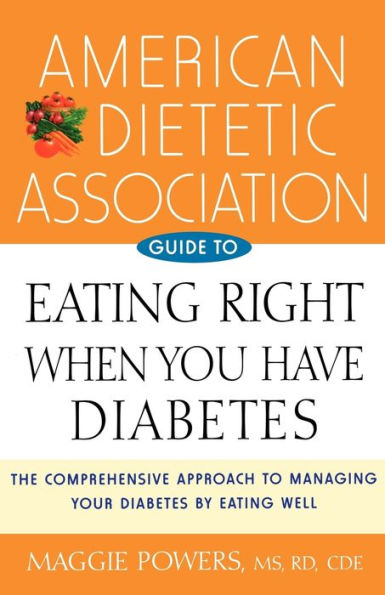The definitive guide to eating well and staying healthy with diabetes
"Nutrition is pivotal to diabetes care. This book is a terrific tool for managing diabetes through good nutrition. It's a guide you can use every day-a treasure chest of advice on how to eat healthfully."
-Richard M. Bergenstal, MD, Executive Director
International Diabetes Center, Minneapolis, Minnesota
From the American Dietetic Association comes this authoritative guide to choosing foods to control your blood sugar and maintain an active, healthy lifestyle. It provides the must-know basics of daily diabetes care-from designing a food plan and preventing low blood glucose levels to losing weight and carbohydrate counting-so you can personalize diabetes and food decisions to fit your needs. You'll see how to manage blood fat levels and blood pressure-an important part of diabetes care-and gain invaluable insight into making healthy food choices and planning tasty meals. You'll also find tips on reducing sugar and fat in foods; quick and easy meal ideas; and a special section on prevention of type 2 diabetes.
* Detailed menu plans for daily caloric levels of 1,200, 1,500, 1,800, 2,000, and 2,500 calories
* Includes fast-food restaurant and ethnic food guides
* Ratings for high, low, and moderate glycemic index foods
"1102543088"
"Nutrition is pivotal to diabetes care. This book is a terrific tool for managing diabetes through good nutrition. It's a guide you can use every day-a treasure chest of advice on how to eat healthfully."
-Richard M. Bergenstal, MD, Executive Director
International Diabetes Center, Minneapolis, Minnesota
From the American Dietetic Association comes this authoritative guide to choosing foods to control your blood sugar and maintain an active, healthy lifestyle. It provides the must-know basics of daily diabetes care-from designing a food plan and preventing low blood glucose levels to losing weight and carbohydrate counting-so you can personalize diabetes and food decisions to fit your needs. You'll see how to manage blood fat levels and blood pressure-an important part of diabetes care-and gain invaluable insight into making healthy food choices and planning tasty meals. You'll also find tips on reducing sugar and fat in foods; quick and easy meal ideas; and a special section on prevention of type 2 diabetes.
* Detailed menu plans for daily caloric levels of 1,200, 1,500, 1,800, 2,000, and 2,500 calories
* Includes fast-food restaurant and ethnic food guides
* Ratings for high, low, and moderate glycemic index foods
American Dietetic Association Guide to Eating Right When You Have Diabetes
The definitive guide to eating well and staying healthy with diabetes
"Nutrition is pivotal to diabetes care. This book is a terrific tool for managing diabetes through good nutrition. It's a guide you can use every day-a treasure chest of advice on how to eat healthfully."
-Richard M. Bergenstal, MD, Executive Director
International Diabetes Center, Minneapolis, Minnesota
From the American Dietetic Association comes this authoritative guide to choosing foods to control your blood sugar and maintain an active, healthy lifestyle. It provides the must-know basics of daily diabetes care-from designing a food plan and preventing low blood glucose levels to losing weight and carbohydrate counting-so you can personalize diabetes and food decisions to fit your needs. You'll see how to manage blood fat levels and blood pressure-an important part of diabetes care-and gain invaluable insight into making healthy food choices and planning tasty meals. You'll also find tips on reducing sugar and fat in foods; quick and easy meal ideas; and a special section on prevention of type 2 diabetes.
* Detailed menu plans for daily caloric levels of 1,200, 1,500, 1,800, 2,000, and 2,500 calories
* Includes fast-food restaurant and ethnic food guides
* Ratings for high, low, and moderate glycemic index foods
"Nutrition is pivotal to diabetes care. This book is a terrific tool for managing diabetes through good nutrition. It's a guide you can use every day-a treasure chest of advice on how to eat healthfully."
-Richard M. Bergenstal, MD, Executive Director
International Diabetes Center, Minneapolis, Minnesota
From the American Dietetic Association comes this authoritative guide to choosing foods to control your blood sugar and maintain an active, healthy lifestyle. It provides the must-know basics of daily diabetes care-from designing a food plan and preventing low blood glucose levels to losing weight and carbohydrate counting-so you can personalize diabetes and food decisions to fit your needs. You'll see how to manage blood fat levels and blood pressure-an important part of diabetes care-and gain invaluable insight into making healthy food choices and planning tasty meals. You'll also find tips on reducing sugar and fat in foods; quick and easy meal ideas; and a special section on prevention of type 2 diabetes.
* Detailed menu plans for daily caloric levels of 1,200, 1,500, 1,800, 2,000, and 2,500 calories
* Includes fast-food restaurant and ethnic food guides
* Ratings for high, low, and moderate glycemic index foods
14.95
In Stock
5
1

American Dietetic Association Guide to Eating Right When You Have Diabetes
288
American Dietetic Association Guide to Eating Right When You Have Diabetes
288Paperback(First Edition)
$14.95
14.95
In Stock

Product Details
| ISBN-13: | 9780471442226 |
|---|---|
| Publisher: | TURNER PUB CO |
| Publication date: | 01/01/2003 |
| Edition description: | First Edition |
| Pages: | 288 |
| Sales rank: | 387,332 |
| Product dimensions: | 5.54(w) x 8.46(h) x 0.73(d) |
About the Author
From the B&N Reads Blog
